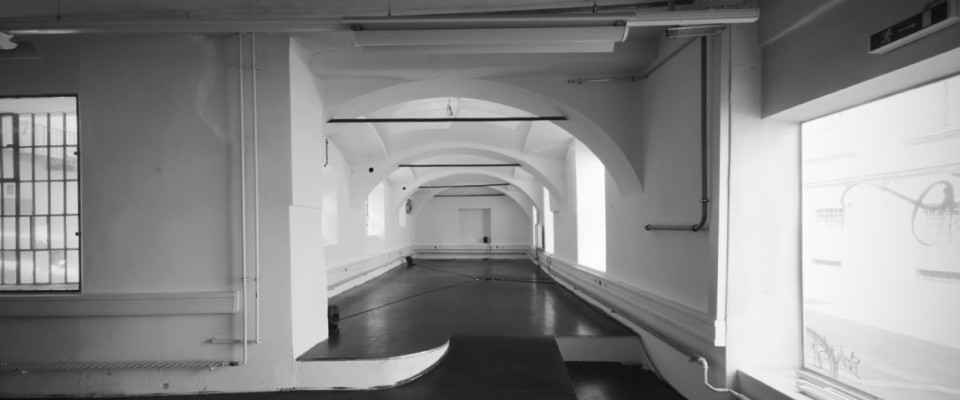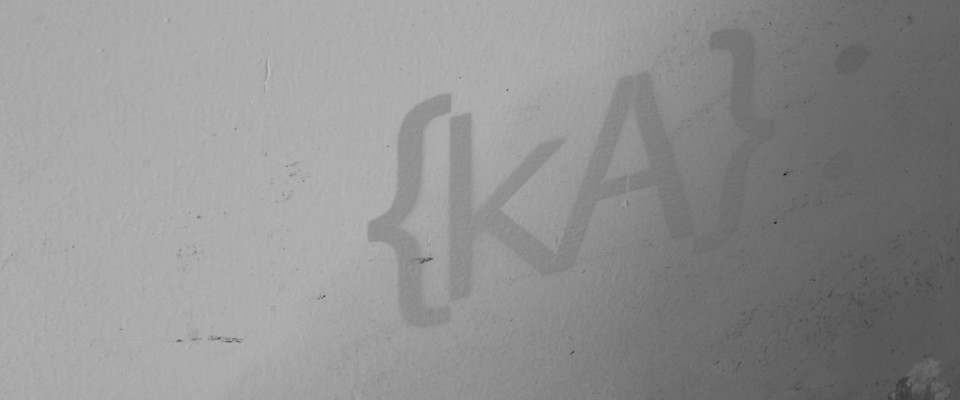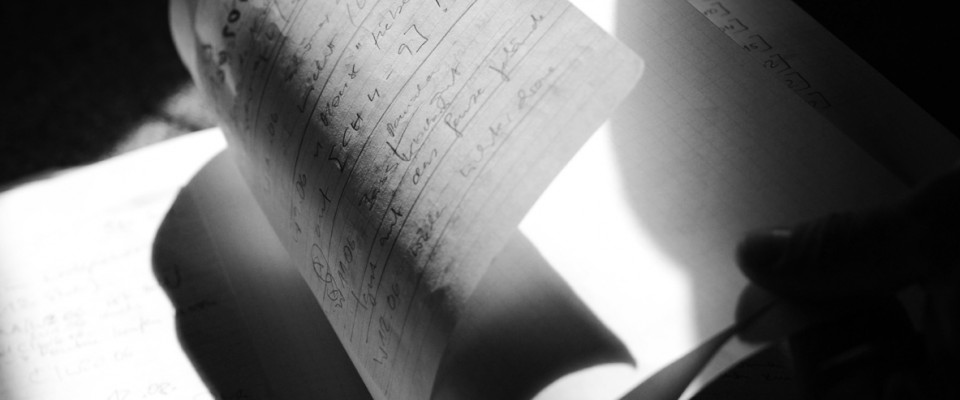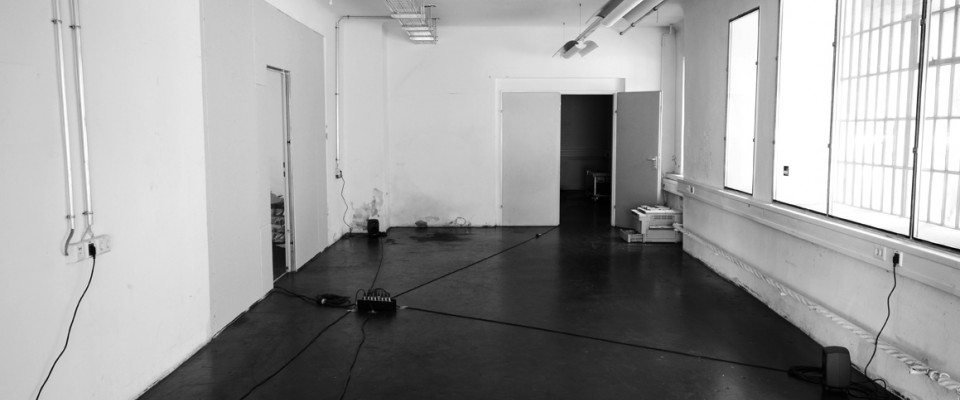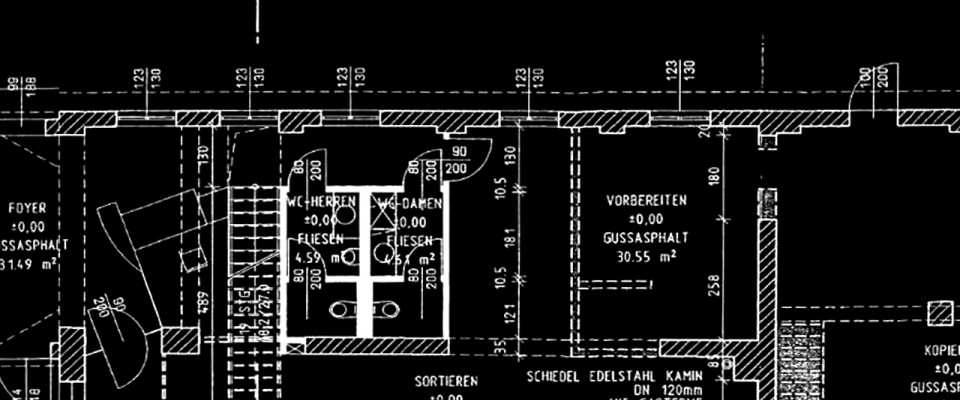The second building used in the series {kA}: Oblivious to Gravity is house number 4 on the street Sauraugasse. It dates back to the early 17th century and is located in the historical Old City in the first city district, the so-called 'inner city', near Schlossberg castle and the city hall building. The Old City spans six city districts and its typical features are its web of narrow alleys and churches and its homogeneous low-rises, a typical form of architecture in European cities.
{ SURVEY }
Finding an empty building in Graz proved to be quite a complicated task. After much research and several calls, I was able to contact someone from the state administration of Styria. The building suggested for the project was number 4 Sauraugasse. It is an L-shaped building, one side of which is located on the street Sauraugasse, and the other on a side street. During the first viewing of the building in April 2011 in the accompaniment of a man from the Styria local administration, there were offices inside. When I was given the key on August 1 that year and entered the building alone, the building was empty. The atmosphere was thus completely different from what it had been. Where once were tables and cabinets now were merely hard cement flooring, large glass surfaces facing the street and the courtyard, where there were large metal doors and remnants of earlier occupiers of the building like metal scraps, garbage bags, an old plotter, piles of rubble and a heap of metal signs with the word 'Ortsbildschutzgebiet' printed on them.
Aside from that, there is a lot of light and sounds from outside that penetrate through the windows and into the halls. It all has the atmosphere of a workshop — bare rooms, long reverberation times, diffuse. Looking at the blueprint sent to me by the Styria administration, two walls on the ground floor in the wing facing the side street seem to be missing. New rooms had been built and drywalls put up. During the first week, I sit on a chair in different corners on the ground floor. During office hours, the sound of cars driving over a loose manhole cover and of a few pedestrians on the street walking by can be heard. Every now and again, a church bell rings and sometimes the sound of people talking in the courtyard can be heard. The ground floor is divided up into small rooms that lead to further segments. There is not a hallway from which all rooms go off. If you open all of the doors in the inner section, you can hear almost all of the sounds outside at different volumes. If you only crack the doors, the sounds are audibly muffled and filtered. On the weekends, there are fewer cars and more pedestrians. Masses of people walking to the city park pass the house. On Saturday night, there is a caravan of party people moving slowly from the castle Schlossberg to the Forum Stadtpark; they rumble on into the wee hours of the morning. I sit inside in the dark. I am right in the middle of a busy, bustling city and see the shadows of people passing; I can see their silhouettes, hear the reverberation of their voices, and footsteps that sound through the building, and have the feeling I am dissolving into this fog of sound. {…}
{ HISTORY }
The Sauraugasse is a straight, narrow street that runs from the Paulustorgasse to the city park 'Stadtpark'. Located near the beginning of the street, is the Wildenstein Palace – a baroque building that today is used as a police department. The Sauraugasse was formerly called Basteigasse before being renamed in 1934.
Throughout its long history, building 4 has had numerous owners and has served an array of different purposes. It is a 4-storey corner house, with a charming, traditional Austrian roof. It was built in the year 1612 and renovated in 1861, at which time it received a new facade. The building encompasses a courtyard, flanked by two-storey wings on the sides. One of the wings was used for the project {kA}: Oblivious to Gravity.
In the 19th century, the inn 'zum Goldenen Apfel' was located at Sauraugasse 4. Later it was used by the hospital on the street Paulustorgasse as staff living quarters. The 2-storey wings in the courtyard buildings were renovated to suit business purposes in 1953. Later the building was rented by Medienfabrik Graz and used as office and storage areas. During this time the building was remodeled to give it the look it has today.
Later, after the building was handed back to the government of Steiermark, it was used as a 'storage' while the buildings at Karmeliterplatz 2 and Paulustorgasse 4 were remodelled. They were then used for the conservation department before being used as an office for the Old Town Commission.
As is often the case with old buildings, there are also stories surrounding Sauraugasse 4. One story goes like this: one day the former head of the Forum Stadtpark’s fine arts department went for a walk down the street accompanied by a man. At this time, the building had been being used as storage space for furniture. The man walking with the woman showed interest in using the furniture in his art. So she agreed to allow him access to it. And that’s how part of the Sauraugasse 4 came to be used in Martin Kippenberger’s Kafka installation.
{ Source }
›Österreichische Kunsttopographie volume LIII‹, published by Bundesdenkmalamt.
›Die Kunstdenkmäler der Stadt Graz. Die Profanbauten des I. Bezirkes, Altstadt‹, edited by Wiltraud Resch Wien, Anton Schroll 1997, 417-541.
{kA}: Listening Spot
After my experience in Wurzburg, I concentrate very early on the stairs in the Graz building. It is an open set of stairs made out of concrete and connecting the first and second floors, it is a natural acoustical “bridge“ spatial system of both floors. Standing at the top of the stairs, one can hear acoustical occurrences on both floors. After just one week it is clear to me that this point will be the listening point for my composition. This is where I set up the digital audio equipment and laptop for the subsequent spatial inquiry.
{...}
{...}
The building reacts completely different than the building in Wurzburg and test rooms. During the first spatial inquiry, I realize I will have to deal with different reverberation times on the first floor. The maze of rooms, connected by a number of doors, creates a dense fog of reflections. Some of the software based inquiry tools created over the past few months are swallowed up by the mixture of reverberations and outside noises and become barely audible due to the great distance between the source and the ear.
Thus it takes a while for the inquiry to deliver coherent answers using the acoustic toolbox. The burst, pulse and movement tools provoke wafting sound clouds.
The results from the individual rooms amalgamate quickly if too many questions are asked or if they are asked too quickly. Unsurprisingly, the first recordings are completely erratic.
A further challenge is that the tools are played back and stopped individually and manually on the laptop. But for this building, an automated inquiry is required, as I have to move around to note the differences produced by individual sounds from the source to the listening point and in other parts of the building. The distances here are much greater than in other buildings surveyed and the coloration and the damping of the sounds and the combination thereof can only be understood if further listening points are positioned as a help along the way to the planned concert spot.
In cooperation with Thomas Musil, I created a universal spatial inquiry tool that we developed and tested in the building. {…}
»I don’t always understand what I am working on. If I did, I wouldn’t have to work on it. But I let the listener (audience) in on my experiences and discoveries.«
[HEINER GOEBBELS, ›Komposition als Inszenierung‹, p.139]
Oblivious to Gravity is a compositional approach that results from and exists in dialogue with its given — musical, medial, organizational, and technical circumstances. For me, it is about learning and further cultivating my compositional possibilities under such self-imposed conditions. With Oblivious to Gravity I aim to work out a flexible and adjustable artistic practice. Confronting oneself with the changing conditions and also having to 'find a new orientation' is all part of the every-day challenge of working in and around buildings to establish this artistic technology. All the while, I seek contact with local audiences to test my work and terminology on outside perceptions.
The building’s soundscape is made up of 7 prominent elements:
The church bells ringing in the distance, cars driving by on their way to or from the parking garage, the pedestrians passing by on their way to the park, the creaking of the beams beneath the ceiling, the creaking of the wooden floors and the electrical clicking of the lamps in the evening and the sounds from the courtyard, where people living in the area park their cars and talk amongst themselves.
Depending on the day of the week and the weather conditions, the wind howls in the attic, and shreds of sounds from concerts at the Schlossberg blow over. And every Saturday at 12 o’clock, there is a fire alarm in the city. {…}
The building is a non-place for which I created a six-part spatial sound composition with 32 loudspeakers mounted at distinct spots, playing with different and moving spatial textures in regard to the acoustics of the building and the environmental sounds. This segmentation gives the listeners’ ear an orientation as they flow through the building hinting a familiarity to the unknown and the space itself. Furthermore, swelling and decaying bass structures are pumped from time to time into the area of the restrooms until the walls start to vibrate. These vibrations and rattling are used as percussive elements and physically placed in the middle of the sound composition. The sounds change as they move through the building depending on the filtering of the individual elements of each room. A sound occurs as a listener is passing by, then disappears into a course of continual repetition throughout the building’s spatial fabric, tracing a line through the space that gets thinner and thinner towards the end before becoming noting more than a memory only to come back again, get closer and leave again.
The first half of the piece was seated at a distinct listening point inside the building.
In the second part, the same composition is played again but this time, while the listeners are moving about the building. Integrated into the sounds, it seems as though there are encounters, cinematic moments in the netting of space. The sounds from the visitors mix with those of the sound composition. Each footstep becomes a sonic each inkling of sound is heard in relation to all other ones. By having the audience move through the building during the concert, the auditory experience becomes a visual one. Right in the middle of the mixture of moving and scaled sounds, there are pictures frozen in time, snapshots: a coffee machine, a sink, a pile of rubble, an unhinged door, a glass cell.
Contrary to my work at Villa 03 in Wurzburg, where only three people could listen simultaneously and the exact concert situation was generated one time, it became clear after just a few days at number 4 Sauraugasse that up to 10 people could sit on chairs at the listening point. I also thought it was important to create a listening situation for multiple groups. So after the first week of inquiry, the Chambers for Space Inquiries sent out an announcement that the concert would be held over two days. Fliers were also printed and distributed near the building.
Excerpt from the invitation:
House number four Sauraugasse has been used as a space to experiment acoustic art since August 1. After a one-week inquiry of the premises, I started with the development of sound material and acoustic spatial situations which have gradually come together to form the building composition. The composition is expected to be finished by mid August and will be presented in concerts on August 29 and 30. As the building is vacant and is not an conventional form of venue, we request all who wish to see the performance make a reservation via email at {sharma@kavs.cc}.
Chairs for 10 people will be set up at the top of the staircase, from which point the composition should be listened to, as this is the sweet spot of the composition. In order to provide the best possible listening experience, we ask that all who are interested in attending the concert make a reservation as early as possible.





